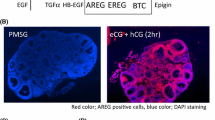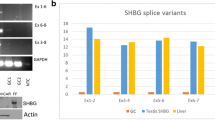Abstract
Epidermal growth factor (EGF) and transforming growth factor alpha (TGF-α) are structurally related growth factors that exert their biological actions by binding to the same cell-surface receptor, EGF receptor. However, in chicken cells, human EGF binds with approximately 100-fold lower affinity than human TGF-α. In a previous study, we localized EGF/TGF-α receptor immunohistochemically in the granulosa and theca of the developing follicles of laying hens. We have also shown that TGF-α binds to cell-surface receptors of the granulosa cells. The present study characterizes the nature of the EGF/TGF-α receptor. Immunoprecipitation of receptor proteins from cultured granulosa cells with an anti-EGF receptor antibody (12E) shows the expression of a 170-kDa receptor protein. The expression of the receptor protein decreases with follicular enlargement between the F3 and F1. Incubation of the cells with [125I]TGF-α followed by crosslinking with bis(sulphosuccinimidyl)suberate showed that TGF-α binds a similar (170 kDa) receptor protein immunoprecipitated with the 12E anti-EGF receptor antibody. The binding of TGF-α to granulosa cells caused receptor protein oligomerization, yielding the monomeric (170 kDa) and dimeric (340 kDa) protein forms. Oligomerization seemed to favour the formation of the dimeric rather than the monomeric form. Culturing granulosa cells with luteinizing hormone or follicle-stimulating hormone increased the expression of both monomer and dimer forms of the receptor proteins compared with the control. Western blotting analysis with anti-phosphotyrosine antibody revealed that the lysates of TGF-α-stimulated cells express phosphotyrosine-containing receptor proteins of 170 kDa and 340 kDa. The results show that chicken granulosa cells express the 170-kDa EGF=TGF-α receptor protein, which dimerizes on binding to TGF-α, suggesting that the receptor protein may be involved in the signal transduction of TGF-α actions in the chicken granulosa cells.
Similar content being viewed by others
References
Ayyagari, R.R. & Khan-Dawood, F.S. (1987) Human corpus luteum; presence of epidermal growth factor receptors and binding characteristics. Am. J. Obstet. Gynecol. 156, 942-6.
Bendell, J. J. & Dorrington, J.H. (1990) Epidermal growth factor influences growth and differentiation of rat granulosa cells. Endocrinology 127, 533-40.
Cadena, D.L., Chan, Chung-Leung & Gill, G.N. (1994) The intra-cellular tyrosine kinase domain of the epidermal growth factor receptor undergoes a conformational changes upon autophosphorylation. J. Biol. Chem. 269, 260-5.
Calvo, J.C., Radicella, J.P. & Charreau, E.H. (1983) Measurement of specific radioactivities of labelled hormones by self displacement analysis. Biochem. J. 212, 259-64.
Cochet, C., Kashles, O., Chambaz, E.M., Borrello, I., King, C.R. & Schlessinger, J. (1988) Demonstration of epidermal growth factor-induced receptor dimer-ization in living cells using a chemical covalent crosslinking agent. J. Biol. Chem. 263, 3290-5.
Derynck, R. (1988) Transforming growth factor α. Cell 54, 593-5.
Feng, P., Knetch, M. & Catt, K. J. (1987) Hormonal control of epidermal growth factor receptors by gonadotrophins during granulosa cell differentiation. Endocrinology 120, 1121-6.
Fujinaga, H., Yamoto, M., Shikone, T. & Nakano, R. (1994) FSH and LH up-regulate epidermal growth factor receptors in rat granulosa cells. J. Endocrinol. 140, 171-7.
Gospodarowicz, D. & Bialecki, H. (1979) Fibroblast and epidermal growth factors are mitogenic agents for cultured granulosa cells in rodents, porcine and human origin. Endocrinology 104, 757-64.
Hanks, S.K. (1991) Eukaryotic protein kinases. Curr. Opin. Struct. Biol. 1, 369-83.
Hunter, T. & Cooper, J.A. (1985) Protein tyrosine kinases. Annu. Rev. Biochem. 54, 897-930.
Hurwitz, D.R., Emmanuel, S.L., Nathans, M.H., Server, N., Ullrich, A., Felder, S., Lax, I. & Schlessinger, J. (1991) EGF induces increased ligand binding affinity and dimerization of soluble epidermal growth factor (EGF) receptor extracellular domain. J. Biol. Chem. 266, 22035-43.
Kennedy, T.G., Brown, K.D. & Vaughan, T.J. (1993) Expression of the genes for the epidermal growth factor receptor and its ligands in the porcine corpora lutea. Endocrinology 132, 1857-9.
Kramer, R.H., Lenfermik, A.E.G., Van Bueren-Koornneef, I.L., Van Der Meer, A., Van De Poll, M.L.M. & Van Zoelen, E. J. J. (1994) Identification of the high affinity binding site of TGFα for the chicken epidermal growth factor (EGF) receptor using EGF/TGFα chimeras. J. Biol. Chem. 269, 8708-11.
Labarca, L. & Paigen, K. (1980) A simple, rapid and sensitive DNA assay procedure. Anal. Biochem. 102, 344-352.
Laemmli, U.K. (1970) Cleavage of structural proteins during the assembly of the head of bacteriophage T4. Nature 227, 680-5.
Lax, I., Johnson, A., Howk, R., Sap, J., Bellot, F., Winkler, M., Ullrich, A., Vennstrom, B., Schlessinger, J. & Givol, D. (1988) Chicken epidermal growth factor (EGF) receptor; cDNA cloning, expression in mouse cells and differential binding of EGF and transforming growth factor alpha. Mol. Cell. Biol. 8, 1970-8.
Lax, I., Bellot, F., Howk, R., Ullrich, A., Givol, D. & Schlessinger, J. (1989) Functional analysis of the ligand binding site of EGF-receptor utilizing chimeric chicken/human receptor molecules. EMBO J. 8, 421-7.
Lax, I., Mita, A.K., Ravera, C., Hurwitz, D.R., Rubinstein, M., Ullrich, A., Stroud, R.M. & Schlessinger, J. (1991) Epidermal growth factor (EGF) induces oligomerization of soluble, extracellular, ligand-binding domain of EGF receptor. J. Biol. Chem. 266, 13828-33.
Li, Z. & Johnson, A.L. (1991) Regulation of P450 cholesterol side-chain in cleavage mRNA expression and progesterone production in hen granulosa cells. Biol. Reprod. 49, 463-469.
Marchalonis, R. (1969) An enzymatic method for the trace iodination of immunoglobins and other proteins. Biochem. J. 113, 299-305.
Maruo, T., Ladines-Llave, C.A., Samoto, T., Matsuo, H., Manalo, A.S., Ito, H. & Mochizuki, M. (1993) Expression of epidermal growth factor and its receptor in the human ovary during follicular growth and regression. Endocrinology 132, 924-31.
Massague, J. (1983) Epidermal growth factor-like transforming growth factor. II. Interaction with epidermal growth factor receptors in human placenta membranes and A431 cells. J. Biol. Chem. 258, 13614-20.
May, J.V., Frost, J.P. & Schomberg, D.W. (1988) Differential effects of epidermal growth factor, somatomedin/ insulin-like growth factor-I and transforming growth factor-beta on porcine granulosa cell deoxyribonucleic acid synthesis and cell proliferation. Endrocrinology 123, 168-79.
Moolenaar, W.H., Biermann, A.J., Tilly, B.C., Verlaan, I., Honeggar, A.M., Ullrich, A. & Schlessinger, J. (1988) A point mutation at the ATP-binding site of the EGF receptor abolishes signal transduction. EMBO J. 7, 707-10.
Onagbesan, O.M. & Peddie, M.J. (1995) Effects of insulin-like growth factor-I and interactions with transforming growth factor-α and luteinizing hormone on cell proliferation and progesterone production by chicken granulosa cells in culture. J. Reprod. Fertil. 104, 259-65.
Onagbesan, O.M., Peddie, M.J. & Williams, J. (1994a) Regulation of cell proliferation and estrogen synthesis by ovine LH, IGF-I and EGF in the theca interstitial cells of the domestic hen cultured in defined media. Gen. Comp. Endocrinol. 94, 261-72.
Onagbesan, O.M., Gullick, W., Woolveridge, I. & Peddie, M. J. (1994b) Immunohistochemical localization of epidermal growth factor receptors and epidermal growth factor-like and transforming growth factor-α-like peptides in chicken ovarian follicles. J. Reprod. Fertil. 102, 147-53.
Onagbesan, O.M., Woolveridge, I. & Peddie, M.J. (1996) Characterization of transforming growth factor-α receptors in the avian ovary; alteration in ligand binding to granulosa cells during follicular maturation. J. Endocrinol. 149, 171-9.
Peddie, M. J., Onagbesan, O.M. & Williams, J. (1994) Chicken granulosa cell proliferation and progesterone production in culture; effects of EGF and theca secretions. Gen. Comp. Endocrinol. 94, 341-56.
Pulley, D.D. & Marrone, B.L. (1986) Inhibitory action of epidermal growth factor on progesterone biosynthesis in hen granulosa cells during short-term culture; two sites of action. Endocrinology 118, 2284-91.
Schlessinger, J. (1986) Allosteric regulation of the epidermal growth factor receptor. J. Cell Biol. 103, 2067-72.
Schlessinger, J. (1988) The epidermal growth factor receptor as a multifunctional allosteric protein. Biochemistry 27, 3119-23.
Shum, L., Reeves, S.A., Kou, A.C., Fromer, E.S. & Derynck, R. (1994) Association of the transmem-brane TGFα precursor with a protein kinase complex. J. Cell Biol. 125, 903-16.
Skinner, M.K. & Coffey, R.J. (1988) Regulation of ovarian cell growth through the local production of TGFα by theca cells. Endocrinology 123, 2632-8.
Sorkin, A. & Carpenter, G. (1991) Dimerization of internalized epidermal growth factor receptors. J. Biol. Chem. 266, 23453-60.
St Arnaud, R., Walker, P., Kelly, P.A. & Labrie, F. (1983) Rat ovarian epidermal growth factor receptors; characterization and hormonal regulation. Mol. Cell. Endocrinol. 31, 43-51.
Thorell, J. I. & Johansson, B.G. (1971) Enzymatic iodination of polypeptides with 125I to high specific activity. Biochim. Biophys. Acta 251, 363-9.
Vanmontfort, D., Vleurick, L., Rombauts, L., Verhoeven, G. & Decuypere, E. (1995) The effect of epidermal growth factor on in vitro inhibin and progesterone production in chicken granulosa cells. Med. Sci. Res. 23, 251-2.
Vlodavsky, I., Brown, K.D. & Gospodarowicz, D. (1978) A comparison of the binding of epidermal growth factor to cultured granulosa and luteal cells. J. Biol. Chem. 253, 3744-50.
Yoshimura, Y. & Tamura, T. (1988) Effects of gonadotrophins, steroids hormones and epidermal growth factor in the in vitro proliferation of chicken granulosa cells. Poultry Sci. 67, 814-18.
Author information
Authors and Affiliations
Rights and permissions
About this article
Cite this article
Onagbesan, O.M., Peddie, M.J. The Expression of Transforming Growth Factor Alpha Receptor Protein and its Activation in Chicken Ovarian Granulosa Cells of Maturing Follicles. Histochem J 30, 647–655 (1998). https://doi.org/10.1023/A:1003544926637
Issue Date:
DOI: https://doi.org/10.1023/A:1003544926637




